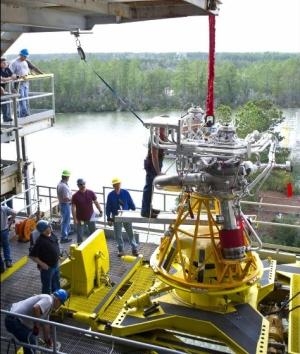Fri, Jan 27, 2012
First New 'Human Rated' Engine To Be Developed In Four
Decades
A new series of tests on NASA's new J-2X engine will begin next
week at NASA's Stennis Space Center in southern Mississippi. NASA
says the tests on the engine bring it one step closer to the first
human-rated liquid oxygen and liquid hydrogen rocket engine to be
developed in 40 years.

Tests will focus on the powerpack for the J-2X. This
highly efficient and versatile advanced rocket engine is being
designed to power the upper stage of NASA's Space Launch System, a
new heavy-lift launch vehicle capable of missions beyond low-Earth
orbit. The powerpack comprises components on the top portion of the
engine, including the gas generator, oxygen and fuel turbopumps,
and related ducts and valves that bring the propellants together to
create combustion and generate thrust. "The J-2X upper stage engine
is vital to achieving the full launch capability of the
heavy-lift Space Launch System," said William Gerstenmaier, NASA's
associate administrator for the Human Exploration and Operations
Mission Directorate. "The testing today will help ensure that a key
propulsion element is ready to support exploration across the solar
system."
About a dozen powerpack tests of varying lengths are slated now
through summer at Stennis' A-1 Test Stand. By separating the engine
components -- the thrust chamber assembly, including the main
combustion chamber, main injector and nozzle -- engineers can more
easily push the various components to operate over a wide range of
conditions to ensure the parts' integrity, demonstrate the safety
margin and better understand how the turbopumps operate.
"By varying the pressures, temperatures and flow rates, the
powerpack test series will evaluate the full range of operating
conditions of the engine components," said Tom Byrd, J-2X engine
lead in the SLS Liquid Engines Office at NASA's Marshall Space
Flight Center in Huntsville, Ala. "This will enable us to verify
the components' design and validate our analytical models against
performance data, as well as ensure structural stability and verify
the combustion stability of the gas generator."
This is the second powerpack test series for J-2X. The powerpack
1A was tested in 2008 with J-2S engine turbomachinery originally
developed for the Apollo Program. Engineers tested these heritage
components to obtain data to help them modify the design of the
turbomachinery to meet the higher performance requirements of the
J-2X engine. "The test engineers on the A-1 test team are excited
and ready to begin another phase of testing which will provide
critical data in support of the Space Launch System," said Gary
Benton, J-2X engine testing project manager at Stennis.
More News
Terminal Radar Service Area Airspace surrounding designated airports wherein ATC provides radar vectoring, sequencing, and separation on a full-time basis for all IFR and participa>[...]
Aero Linx: Utah Back Country Pilots Association (UBCP) Through the sharing experiences, the UBCP has built upon a foundation of safe operating practices in some of the most challen>[...]
From 2010 (YouTube Edition): Imagine... Be The Change... Inspire FROM 2010: One of the more unusual phone calls I have ever received occurred a few years ago... from Anousheh Ansar>[...]
(Pilot) Felt A Shudder And Heard The Engine Sounding Differently, Followed By The Engine Chip Detector Light On April 14, 2025, about 1800 Pacific daylight time, a Bell 206B, N1667>[...]
Also: AMA Names Tyler Dobbs, More Falcon 9 Ops, Firefly Launch Unsuccessful, Autonomous F-16s The Air Force has begun ground testing a future uncrewed jet design in a milestone tow>[...]
 ANN's Daily Aero-Term (05.07.25): Terminal Radar Service Area
ANN's Daily Aero-Term (05.07.25): Terminal Radar Service Area ANN's Daily Aero-Linx (05.07.25)
ANN's Daily Aero-Linx (05.07.25) Classic Aero-TV: Anousheh Ansari -- The Woman Behind The Prize
Classic Aero-TV: Anousheh Ansari -- The Woman Behind The Prize NTSB Prelim: Bell 206B
NTSB Prelim: Bell 206B Airborne-NextGen 05.06.25: AF Uncrewed Fighters, Drones v Planes, Joby Crew Test
Airborne-NextGen 05.06.25: AF Uncrewed Fighters, Drones v Planes, Joby Crew Test



